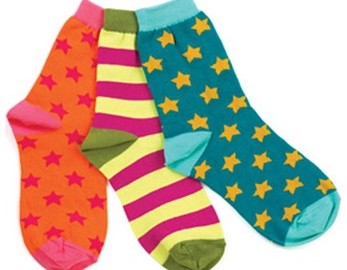
PlaySpace at Home: Sock Matching
This morning’s PlaySpace was a celebration of the classic bedtime story Goodnight Moon.
What we did: One of our activities was a simple sock-matching game that is easy for families to adapt at home. We set out a basket of colorful socks and a clothesline, and encouraged children to compare the colors, patterns, and textures of the socks, match them into pairs, and hang them on the line.
Why it’s important: The ability to compare objects and classify them according to specific traits is a critical early math skill. Recognizing similarities and patterns in everyday things helps children learn to sequence objects and make predictions, which in turn helps them develop logical reasoning abilities. The socks below both have blue stripes, but they’re not exactly the same. When children articulate the ways in which objects are the same and different, they are encouraged to think about alternative ways that those objects can be grouped.


How to do it at home: This one is easy! Ask your child to help you sort socks when you fold laundry. They can match the socks into pairs or sort them into broader categories. Encourage your child to think about different ways the socks can be grouped: by color, texture, or which family member they belong to. Your child can also work on fine motor skills by clipping the socks onto a clothesline.
Taking it to the next level: Once your child has mastered matching objects into pairs and explored various ways of grouping them, you can start to point out more complex patterns in your child’s environment. You can also create your own patterns by stringing colorful beads on a shoelace or building with LEGO. Ask your child to predict the next item in a sequence or identify an object that is out of place.
 Additional reading: For a fun book on this topic, check out A Pair of Socks by Stuart Murphy. It looks at pattern recognition through the story of a lone sock searching for its lost mate, and includes additional activities you can use to further explore these concepts in your child’s everyday life.
Additional reading: For a fun book on this topic, check out A Pair of Socks by Stuart Murphy. It looks at pattern recognition through the story of a lone sock searching for its lost mate, and includes additional activities you can use to further explore these concepts in your child’s everyday life.
~Amy






